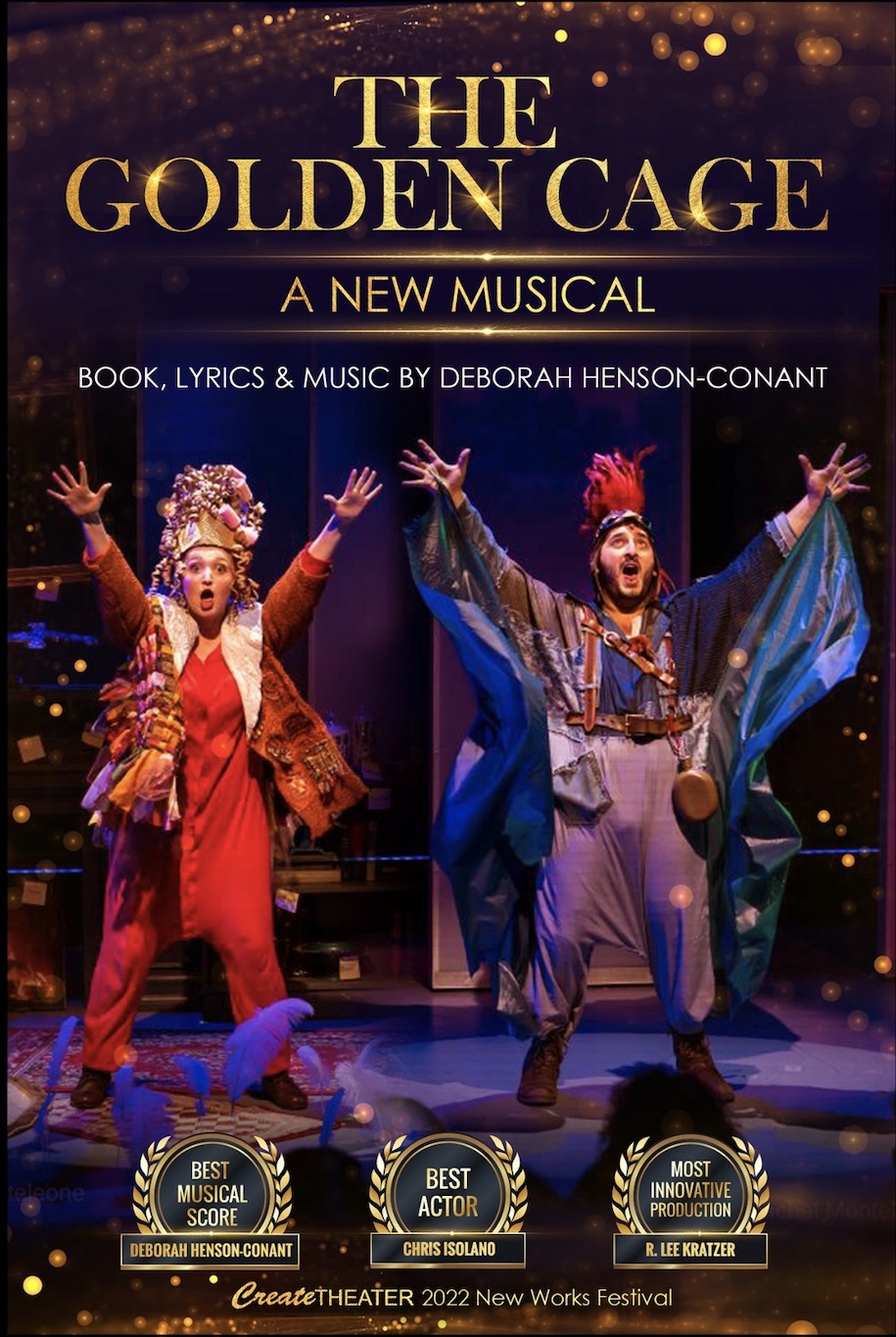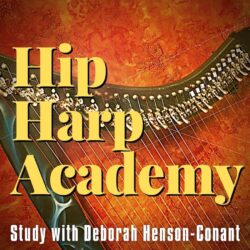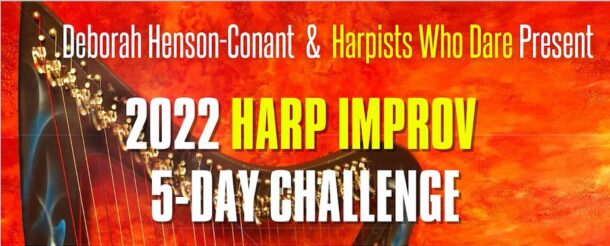This is Conversation #9 of the “Jung at Harp” series with Jungian Analyst Kathleen Wiley and me, Deborah Henson-Conant. In this video we are exploring AUTHENTICITY & WHOLENESS. This series explores Jungian analysis through the lens of the principles in my “Strings of Passion” theory of Creative Resonance: Impulse, Structure, Character, Roles, Practice(s), Deconstruction and Lift-off.
These 7 principles are at the heart of my 10-Week creativity program “Strings of Passion.”
HARPISTS: Learn to apply principles of Freedom and Self-Expression to your playing at Hip Harp Academy. Learn more and register HERE.
Read the Transcript Here (click to open)
DHC (00:01):
Hello and welcome to “Jung at Harp.” I’m Deborah Henson Conant and I’m here with Kathleen Wiley. I’m a composer, performer, and Kathleen is a Jungial analyst — and we are both harp players. We’ve been exploring the seven strings of passion that are at the heart of a book, a concert and a class that I have. They take us from the impulse of creative expression all the way through to the moment of liftoff when we’re actually creatively expressing.
DHC (00:33):
We’ve gone through all seven strings individually in earlier video conversations. And we’ve also looked at the integration of all 7 strings in episode #8.
KW (00:38):
Today we want to look at something specific which is: why are we doing that? Where does Jungian analysis and the way that I teach or look at music – what are we trying to do with that? What are the, what are the things that are the same about them? And, and then looking at the questions of authenticity and wholeness, which both of these things are trying to do and what do those actually mean?
DHC (01:03):
So Kathleen, you were the one who suggested that we talk about authenticity and wholeness. Can you explain what made you think of that?
KW (01:12):
Yeah. You know, when we were talking about what even inspired us to want to have these conversations together and what it is that when people come to me for Jungian analysis or they come to you and your Hip Harp Academy or individual lessons, what is it they’re wanting?
KW (01:28):
And I think what we all want more than anything is to be able to live more authentically and more wholly. And in Jungian Psychology, Jung had a concept he called individuation and he said, is this organic process group which we embody and live more truly who we are as a psyche soul. So that to individuate is to really live the truth of your soul versus as we’ve talked before, living the truth of who you’ve learned you should be, or who you think you should be as the good girl or the church lady or the extravagant musician or whomever.
KW (02:13):
And all of those things could possibly be a part of who you authentically are. But often people adopt personas roles in a negative way that really disconnect them from their heart and soul from what is their own natural expression. So I think when we think about the strings of passion we’ve been talking about and why, what’s kind of like, what’s the, where are we, what direction are we moving in? I don’t want to say what’s the goal because I think it’s more of a process and a journey. But I think what we’re really all moving towards is to be more authentic and to be more authentic means we’re more whole, that we give room and expression to more impulses that are within us and more of our own roles that we want to play with and the characters that live inside of us.
DHC (03:02):
It’s making me think of two things. One is a quote about miles Davis and one thing is that was what my mother said to me and what the quote from that Miles Davis, I won’t say it perfectly, is something like, man, it takes a long time to sound like yourself.
KW (03:17):
Yeah. Yes, yes, absolutely.
DHC (03:21):
And then what made me think of my mother is that when I was a kid and I was asking her about what’s right and wrong, and we started talking about truth. And I remember her one day saying to me, well, there’s the truth. There’s the whole truth and there’s nothing but the truth. And there’s a reason that those three are put together because you can still lie while not telling anything that’s untrue by withholding. And so that’s why I think that it is so beautiful that you brought out the two ideas of authenticity and wholeness.
DHC (03:57):
And I know for sure that, so often it seems like authenticity to me is the breaking down, is the deconstruction of all the things that we think we are so that we can get to the heart and the distillation of who we are. And then the wholeness is sort of the blooming of that seed. And I know for sure that the blooming of that seed does not happen in complete and utter perfection and authenticity that we, you know, what miles Davis said is, you know, it takes a long time. I don’t know exactly if he said ‘find’, but to find out, to actually try all these different things. And that’s why I think one of the strings is, when I talk about practice, the string of practice and one of the things I often say is you have to be bad to be good. You cannot get too connected or authentic or whole without going – I can’t – without going through all kinds of misconceptions and mis- steps and everything like that. So how does that play out in the Jungian idea? And then I can talk about, or we can both talk about how that plays out in music or, or art. I mean, I’m assuming all art, but how it plays out in music, in becoming authentically the musician who you are, which I might add from what I’m hearing other people say to me about my playing , is who I am authentically is not always the me that I think is the most impressive or the one I want to show. The Authentic me is sometimes and possibly always someone who is very easy to be, and sometimes feels like I’m not ‘doing’ anything, so how could this possibly be valuable?
KW (05:54):
Yeah, what you just said there is profound statement, because when we really live from the truth of who we are, it’s easy. It’s effortless, and it can feel like, Oh, um, we’re doing nothing at all. But the truth is we’ve done a lot to get there. I can’t remember when one of my mentor analysts said, when I was getting ready to do a presentation, and I was saying (DHC: watch out about those papers. KW: Yeah, thank you.) And I said, you know, I feel guilty that I’m getting paid this much money to do this because it feels so easy. She said, yes, but you have to remember how much work and money in own analysis it took for you to get to this place that it “feels easy. ” You know?
DHC (06:39):
And I would think, and I’m thinking now that, so that’s still kind of implies that you’ve earned it rather than, because it seems like if we had the understanding we could go there immediately: to simply be ourselves, and I think some artists are able to able to do that.
DHC (07:04):
(KW: Right) And for some artists or human beings, it may take a lifetime. Like I think, you know, it’s taken me a lifetime. And I’m not saying that against what your, what your mentor said. I’m just thinking that we don’t always have to think like, wow, I worked so hard to get here. Like that work is opening up. Right.
KW (07:26):
Well and, but what I’ll say two things to that. I think once you get there, it doesn’t feel like work at all. And the second thing is I think that, what she meant in that case by work is that in the process of socialization, we all learn to be certain ways that block the flow of our own energy. And it is possible that there can be spontaneous kinds of “miraculous” transformations where people flip to the other side of that. But more often than not, it means really having to compassionately take oneself in hand a find the seed that is one’s true nature and then be willing to walk it out of the ‘learn’s, should’s, must’s and ought-to’s’ so it is work and that it requires conscious intention and it requires focus and it requires a practice, if we go back to the string and practice that, it’s great to say it will happen spontaneously and it just ‘is.’ But the truth is, I don’t know that I’ve ever seen anyone where that happened.
DHC (08:46):
Well, they may be off on a mountain in Nepal …
KW (08:51):
… and if you’re there, please join us for the next dialogue because I think that more often than not it is, you know, let me say it this way. Jung says that consciousness is ‘contra naturam’ – that to become conscious goes against nature. That our nature is to just be unconscious, to go on automatic pilot and – let’s just use this for an example to just say whatever we think, not filter, not censor, not relate to that part of this that’s wanting to rage inside. So we just let it fly. That’s, that’s being unconscious. It’s being on automatic pilot and it goes against that to say, ” Oh look at that. I’m really wanting to ream him a new one. What’s that about now? Is that really what I want?” I mean that takes “work” or “effort” – or really what it takes, if we want to take it out of that language is, it just takes conscious presence with oneself.
DHC (09:58):
Okay. That’s very interesting. I’m going to think about — so, in playing music, it’s reminding me of roles of leadership and followship, and how much easier it is to just react instead of actually responding and sometimes we can use that for learning. For example, when I started understanding that, that telling, talking to my students and then telling them and explaining things to them, it wasn’t always working. And, sometimes it was much easier for them if I would just play something and then they played it back. I played it and they played it back. Whether they played it perfectly, you know, it wasn’t about being perfect to the model in any, in any way, but it was about using that, maybe impulse of reaction to actually help them get moving in a way that would then help them to be able to be more creative and improvisitory. So this was on the, on the road to improvisation.
DHC (11:12):
So that’s really interesting that, um, what I’m hearing is that we are just, if we could just sit around and just react, I’m thinking about a sea anemone. Like somebody just touched me and I’m going in, Oh, now the sea is here, I’m going out. And like, that’s basically it then that is, that is very simple. And you know, part of the glory and opportunity of being human is that we do have the opportunity for more. And it sounds like that ‘more’ can come through, looking at reaction and starting to open it up into response.
KW (11:57):
Yes. I mean, you’re making, I think an important distinction is that reaction is something that just happens automatically. And we don’t have a presence of self to be with that and look at all the other possibilities. But when we can respond, when we can keep ourself in relationship to the impulse to react and then decide how do we want to respond to the impulse, what are the myriad possibilities of how we respond to the impulse, then we begin to be able to bring more of ourself in the moment.
KW (12:34):
Wow. So I’m going back, I’m going back to the strings. I’m thinking this is how I think about S so and just to reiterate for people the strings of passion and they should be written, you know, either in the, um, in the definition or the end of the description in YouTube or on the page where you’re seeing this. But their impulse is the first, the second is the string of, um, structure. So that gives the impulse, something to live on, like an internal structure of our skeleton. The third is character. That’s how something comes alive and differentiates. The fourth is the string of roles, which helps us, um, start bringing that down and it actually integrate with other people, do creative things with other people. The fifth string is the string of practice, which I would think is maybe, um, an integration with the thing we’re working with in this case, the harp through time.
KW (13:21):
So that brings in the concept of time of practice and also allowing ourselves, did he change through that? That’s the fifth. The sixth is deconstruction, which is where we break things down, which is what we’re doing so that they can become a seed of many, many, many different kinds of creative expression. And then finally is the moment of liftoff where we reconnect or we, we, we take that through line to the initial impulse and we actually express as we are right now without trying to be anything different. So going back to this idea of impulse that you just talked about, um, when we react to something, it’s an impulse and I just realized that whole somehow maintaining connection to the original impulse or the chosen impulse. So for example, if you’re with somebody who you want to have a relationship with them, you want to be intimate with them, that’s your deepest impulse and now you’re angry. That’s a different impulse. That’s a kind of reactive impulse. How do you get back and reconnect with that original impulse? And this happens in creativity all the time. You have an idea to create something. It’s moving and life gets in the way. Yeah. So we’re really talking about how to get back to that original impulse without all the others. What would you say about fat?
KW (14:44):
Well, and I would say in the example you gave and use the anger in service of the desire for connection instead of acting the anger out to destroy the connection. Because anger is an emotion who’s saying we need to do something different? The problem is we tend to get angry and automatically think they need to do something different. And then we go into anger. We go into rage and bitterness and resentment and controlling behaviors and all those things that do not serve connection. But if we say, wow, I’m really angry when my partner does that, what do I need to do differently? All right, well maybe what I need to do is just accept this is part of the way they move in the world and I need to find a way to move around it. Maybe what I need to do is just back off and let him be in the kitchen by himself when he’s there. If it’s a kitchen issue, you know? Um, but we look at the anger and say, what’s it telling me? But we look at it, what’s it telling me I need to do and service of my desire to stay connected to this person?
KW (15:54):
Wow. Okay. So what do I need to do in service of this true impulse, whatever that truly impulses. So what? Well, what is a young Ian? What does a young Ian, so, so let me, um, I’m just going to bring out a musical idea that will help in that. And then I want to, I’d love to have you bring out a union idea. So in, in, in music or in creativity or creating things. And I’m, I’m always creating things that are words in music or words, music and story. [inaudible] the things that helped me reconnect to the original impulse are Mmm, eh, uh, visualizations. When I can make a drawing for myself or a map, often something far simpler then I think it should be. And when, so that’s the first thing to make myself some kind of image of what it is I want to do.
KW (16:49):
Okay. And then that’s a structure I could add character to it if I was, if I wanted to decorate it or expand it, but I would go directly to a practice and the practice being, don’t just make it, but revisit it, revisit it, revisit it, revisit it and open up that relationship. If I, if I’m, and that’s what I did for example, I was, uh, started to write a musical many, many years ago. Really loved it. And then it fell by the wayside as life took off. And finally I discovered the solution, uh, to bringing it back to life. And that was simply to hire somebody to sit with me for three hours a week at a certain time where we revisit it. And it wasn’t just anybody to sit with me. It was an, it was a musician who was able to play what I had written there.
KW (17:41):
What a however crazy it was. But, um, but I can see that I followed that pattern. I took what I had, even though it seemed like complete mess. I put it in a form that I could hand it to him with all my embarrassment. And shame. And then he played through it and then we added practice. We did this every week. And if PO when I could, I would go back and do some updating during the week. But when I couldn’t, we just played through it again. But that revisiting, revisiting, revisiting was always there and I would call that a practice. So I took the impulse that had gotten, um, um, dis dis is not destructive, corroded. Basically through time I created some structure out of it, whatever, however embarrassing, and then I applied the principle of practice to it. Right. So, so, um, how would you do that? How would young look at that? You’ve got an impulse, you love somebody or you love something. It’s, it’s, it’s in danger of getting corroded or disappearing.
KW (18:46):
Well, I think you have to really stay in relationship to the energy or the what you’re calling the impulse. So, in this case, the desire for love, which we all have, that if we can stay in relationship to that desire for love and chances are in order to do that, if we’re scared, we’re going to have to be willing to also be in relationship to all of the experiences we’ve had where we did want to be loved and we were open to it. But we got something different. We got what felt like a rejection. We got what felt like criticism. We got shamed for it. And that we have to be able thus to keep our desire in spite of those experiences. And that’s part of the work of analysis is how do we, um, revisit or be willing to be with those, those old emotional States that get triggered from historical events so that they can integrate so that they can organically become connected to our conscious cell. Or then we’re more whole and their energy isn’t split off into side-trackers.
[More to come … we’re still editing the transcription]

“Even when something is seemingly broken, it still has its beauty”
~ Kathleen Wiley
(from Episode #9 of "Jung at Harp" YouTube Conversation Series with Kathleen Wiley & Deborah Henson-Conant)

“‘Authentic Me’ is often someone it’s so easy to be that it feels like I’m-not-‘doing’-anything-and-how-could-that-possibly-be-valuable?”
~ Deborah Henson-Conant
(from Episode #9 of "Jung at Harp" YouTube Conversation Series with Kathleen Wiley & Deborah Henson-Conant)

“When we really live from the truth of who we are, it’s effortless, and it can feel like we’re doing nothing at all. But the truth is we’ve done a lot to get there.”
~ Kathleen Wiley
(from Episode #9 of "Jung at Harp" YouTube Conversation Series with Kathleen Wiley & Deborah Henson-Conant)

“In the process of socialization, we all learn to be certain ways that block the flow of our own energy.”
~ Kathleen Wiley
(from Episode #9 of "Jung at Harp" YouTube Conversation Series with Kathleen Wiley & Deborah Henson-Conant)

PROJECTS & PERFORMANCES:
FOR HARPISTS:
- Join Hip Harp Academy
- Harp Time Live (FREE Weekly Playalong)
- FREE Resources





Join for Freebies, Stories & News
Join to get weekly-ish emails with stories, videos & events like concerts & classes
Yay! You should get my next newsletter within the next 7-10 days. I'm so happy we'll be in touch!
I won't ever share your email address with others - and you can unsubscribe anytime, tho most people say they really enjoy these weeklish emails.